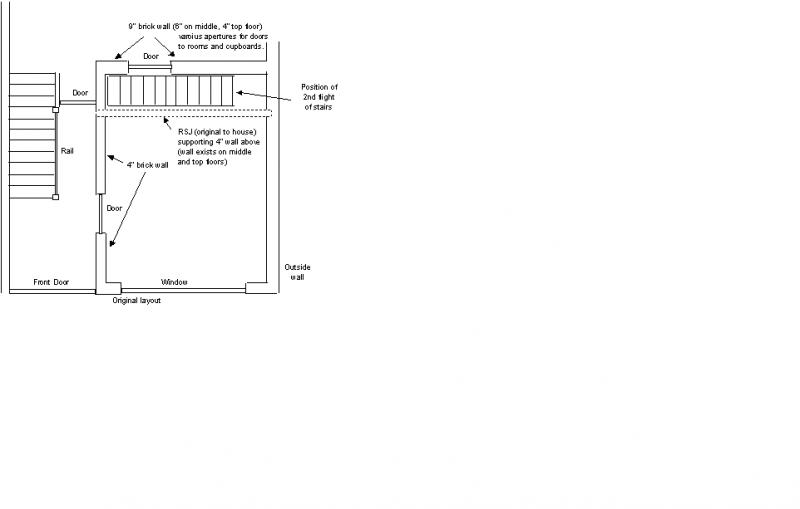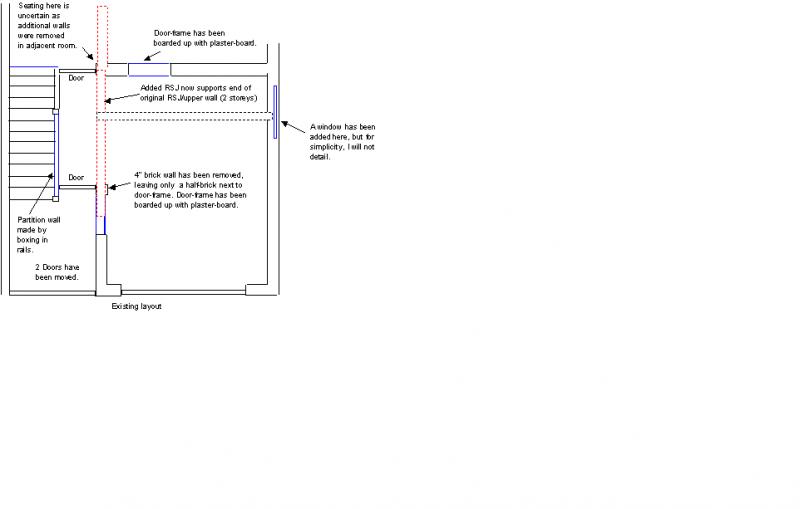Hi,
I have a 3-storey house. A previous owner has had some work done on the ground floor to open up the front room to include part of the passage-way (building a partition wall to block off the side of the stairs). The opening spans 8 feet. The problem is that I've noticed the 2nd flight of stairs is very squeaky and there appears to be some drop in the upper walls in the middle of the house (maybe 15mm). The 2nd flight of stairs is at 90 degrees to the first flight, with a wall at each side.
Upon doing a bit of investigation into the structure of the house, it turns out that the wall to one side of the upper stairs is supported by an RSJ (this is original to the house), secured on one side into the side wall of the house, and the other side originally resting on ... the wall that has been removed . Thus we now have an RSJ (which holds the weight of the upper 2 floors) resting on another RSJ
. Thus we now have an RSJ (which holds the weight of the upper 2 floors) resting on another RSJ  .
.
I had a builder around to give me an idea of how to remedy the situation.
We took up a few floor-boards on the middle floor and found the joists were resting on the newer RSJ, but had been packed with wooden spacers.
The original RSJ was sat directly on the newer one.
The builder thought (from looking at the dimensions of the covered RSJ) that it wasn't very substantial (4" x 6" at best, but probably more like 4" x 5" if you take the packing under the joists into account). He suggested replacing it with something bigger.
So my first question:
The end of the original RSJ now rests on the newer one, approx 3 feet from the nearest end. Effectively this is a point load onto it, and since all metal gives to some extent, is it not just acting as a giant spring? Is it possible to construct like this and expect to keep the upper 2 floors rigid?
My initial thought was the only way out was to re-build the removed wall.
The "bounce" in the wall (at the side of the second flight of stairs) is noticable if you have your head leaning against it when the teen-age kids go charging up the stairs .
.
The other issue I have is the securing points for each end of the proposed replacement RSJ. Since including part of the passage-way, the room has now become L-shaped. Only half of the wall was removed to add part of the passage-way. One end of the RSJ sits on top of the remaining 4" wall, and the RSJ spans over the gap created by the wall's removal. The second end of the RSJ sits on the original corner of the room. This happens to be at the end of a 9" wall.
I'm fairly happy with the 9" wall end, as it's a substantial wall, but the other end... wouldn't that have to be strengthened in some manner?
I'm rather nervous about supporting the upper 2 storeys of the house on an RSJ resting on the top of the very end of a 6' long section of wall, only 4" wide... Even with my limited experience of DIY, I know that it doesn't take much of a knock to the corner of a 4" wall to break a couple of bricks off. Likewise blocks are not particularly sturdy at the corners either.
Hope my explanation is sufficient to describe the situation.
I have no experience of installing RSJs, and have never seen one installed in the middle of a house like this (normally they span the entire width). I just dont want to spend the dosh and find I've not entirely fixed the problem!
Can anyone give any advice on this?
Thanks,
Mike
I have a 3-storey house. A previous owner has had some work done on the ground floor to open up the front room to include part of the passage-way (building a partition wall to block off the side of the stairs). The opening spans 8 feet. The problem is that I've noticed the 2nd flight of stairs is very squeaky and there appears to be some drop in the upper walls in the middle of the house (maybe 15mm). The 2nd flight of stairs is at 90 degrees to the first flight, with a wall at each side.
Upon doing a bit of investigation into the structure of the house, it turns out that the wall to one side of the upper stairs is supported by an RSJ (this is original to the house), secured on one side into the side wall of the house, and the other side originally resting on ... the wall that has been removed
I had a builder around to give me an idea of how to remedy the situation.
We took up a few floor-boards on the middle floor and found the joists were resting on the newer RSJ, but had been packed with wooden spacers.
The original RSJ was sat directly on the newer one.
The builder thought (from looking at the dimensions of the covered RSJ) that it wasn't very substantial (4" x 6" at best, but probably more like 4" x 5" if you take the packing under the joists into account). He suggested replacing it with something bigger.
So my first question:
The end of the original RSJ now rests on the newer one, approx 3 feet from the nearest end. Effectively this is a point load onto it, and since all metal gives to some extent, is it not just acting as a giant spring? Is it possible to construct like this and expect to keep the upper 2 floors rigid?
My initial thought was the only way out was to re-build the removed wall.
The "bounce" in the wall (at the side of the second flight of stairs) is noticable if you have your head leaning against it when the teen-age kids go charging up the stairs
The other issue I have is the securing points for each end of the proposed replacement RSJ. Since including part of the passage-way, the room has now become L-shaped. Only half of the wall was removed to add part of the passage-way. One end of the RSJ sits on top of the remaining 4" wall, and the RSJ spans over the gap created by the wall's removal. The second end of the RSJ sits on the original corner of the room. This happens to be at the end of a 9" wall.
I'm fairly happy with the 9" wall end, as it's a substantial wall, but the other end... wouldn't that have to be strengthened in some manner?
I'm rather nervous about supporting the upper 2 storeys of the house on an RSJ resting on the top of the very end of a 6' long section of wall, only 4" wide... Even with my limited experience of DIY, I know that it doesn't take much of a knock to the corner of a 4" wall to break a couple of bricks off. Likewise blocks are not particularly sturdy at the corners either.
Hope my explanation is sufficient to describe the situation.
I have no experience of installing RSJs, and have never seen one installed in the middle of a house like this (normally they span the entire width). I just dont want to spend the dosh and find I've not entirely fixed the problem!
Can anyone give any advice on this?
Thanks,
Mike



